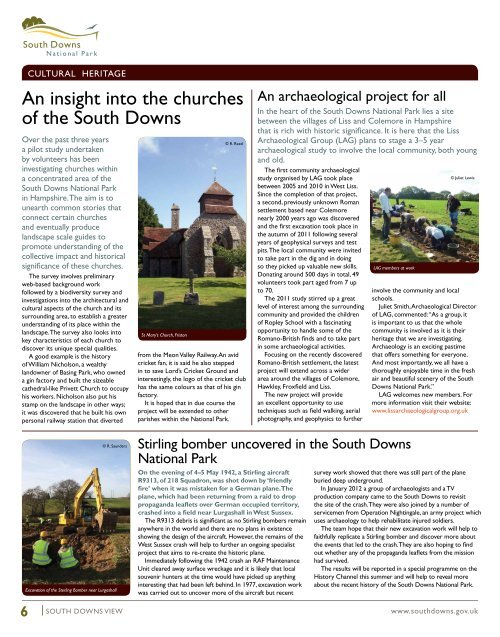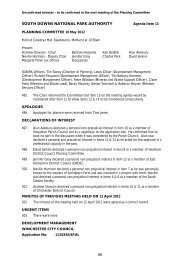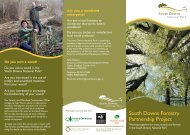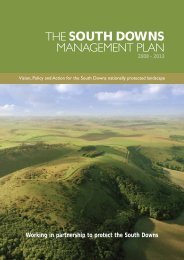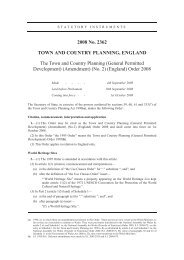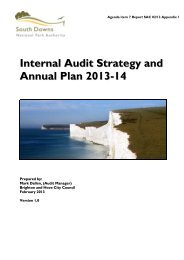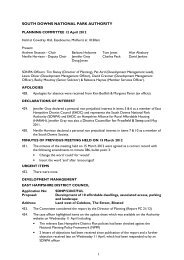South Downs View - South Downs National Park Authority
South Downs View - South Downs National Park Authority
South Downs View - South Downs National Park Authority
- No tags were found...
Create successful ePaper yourself
Turn your PDF publications into a flip-book with our unique Google optimized e-Paper software.
cultural heritageAn insight into the churchesof the <strong>South</strong> <strong>Downs</strong>Over the past three yearsa pilot study undertakenby volunteers has beeninvestigating churches withina concentrated area of the<strong>South</strong> <strong>Downs</strong> <strong>National</strong> <strong>Park</strong>in Hampshire. The aim is tounearth common stories thatconnect certain churchesand eventually producelandscape scale guides topromote understanding of thecollective impact and historicalsignificance of these churches.The survey involves preliminaryweb-based background workfollowed by a biodiversity survey andinvestigations into the architectural andcultural aspects of the church and itssurrounding area, to establish a greaterunderstanding of its place within thelandscape. The survey also looks intokey characteristics of each church todiscover its unique special qualities.A good example is the historyof William Nicholson, a wealthylandowner of Basing <strong>Park</strong>, who owneda gin factory and built the sizeablecathedral-like Privett Church to occupyhis workers. Nicholson also put hisstamp on the landscape in other ways;it was discovered that he built his ownpersonal railway station that divertedSt Mary’s Church, Friston© R. Reedfrom the Meon Valley Railway. An avidcricket fan, it is said he also steppedin to save Lord’s Cricket Ground andinterestingly, the logo of the cricket clubhas the same colours as that of his ginfactory.It is hoped that in due course theproject will be extended to otherparishes within the <strong>National</strong> <strong>Park</strong>.An archaeological project for allIn the heart of the <strong>South</strong> <strong>Downs</strong> <strong>National</strong> <strong>Park</strong> lies a sitebetween the villages of Liss and Colemore in Hampshirethat is rich with historic significance. It is here that the LissArchaeological Group (LAG) plans to stage a 3–5 yeararchaeological study to involve the local community, both youngand old.The first community archaeologicalstudy organised by LAG took placebetween 2005 and 2010 in West Liss.Since the completion of that project,a second, previously unknown Romansettlement based near Colemorenearly 2000 years ago was discoveredand the first excavation took place inthe autumn of 2011 following severalyears of geophysical surveys and testpits. The local community were invitedto take part in the dig and in doingso they picked up valuable new skills.Donating around 500 days in total, 49volunteers took part aged from 7 upto 70.The 2011 study stirred up a greatlevel of interest among the surroundingcommunity and provided the childrenof Ropley School with a fascinatingopportunity to handle some of theRomano-British finds and to take partin some archaeological activities.Focusing on the recently discoveredRomano-British settlement, the latestproject will extend across a widerarea around the villages of Colemore,Hawkley, Froxfield and Liss.The new project will providean excellent opportunity to usetechniques such as field walking, aerialphotography, and geophysics to furtherLAG members at work© Juliet Lewisinvolve the community and localschools.Juliet Smith, Archaeological Directorof LAG, commented: “As a group, itis important to us that the wholecommunity is involved as it is theirheritage that we are investigating.Archaeology is an exciting pastimethat offers something for everyone.And most importantly, we all have athoroughly enjoyable time in the freshair and beautiful scenery of the <strong>South</strong><strong>Downs</strong> <strong>National</strong> <strong>Park</strong>.”LAG welcomes new members. Formore information visit their website:www.lissarchaeologicalgroup.org.uk© R. SaundersExcavation of the Sterling Bomber near Lurgashall6south downs <strong>View</strong>Stirling bomber uncovered in the <strong>South</strong> <strong>Downs</strong><strong>National</strong> <strong>Park</strong>On the evening of 4–5 May 1942, a Stirling aircraftR9313, of 218 Squadron, was shot down by ‘friendlyfire’ when it was mistaken for a German plane. Theplane, which had been returning from a raid to droppropaganda leaflets over German occupied territory,crashed into a field near Lurgashall in West Sussex.The R9313 debris is significant as no Stirling bombers remainanywhere in the world and there are no plans in existenceshowing the design of the aircraft. However, the remains of theWest Sussex crash will help to further an ongoing specialistproject that aims to re-create the historic plane.Immediately following the 1942 crash an RAF MaintenanceUnit cleared away surface wreckage and it is likely that localsouvenir hunters at the time would have picked up anythinginteresting that had been left behind. In 1977, excavation workwas carried out to uncover more of the aircraft but recentsurvey work showed that there was still part of the planeburied deep underground.In January 2012 a group of archaeologists and a TVproduction company came to the <strong>South</strong> <strong>Downs</strong> to revisitthe site of the crash. They were also joined by a number ofservicemen from Operation Nightingale, an army project whichuses archaeology to help rehabilitate injured soldiers.The team hope that their new excavation work will help tofaithfully replicate a Stirling bomber and discover more aboutthe events that led to the crash. They are also hoping to findout whether any of the propaganda leaflets from the missionhad survived.The results will be reported in a special programme on theHistory Channel this summer and will help to reveal moreabout the recent history of the <strong>South</strong> <strong>Downs</strong> <strong>National</strong> <strong>Park</strong>.www.southdowns.gov.uk


